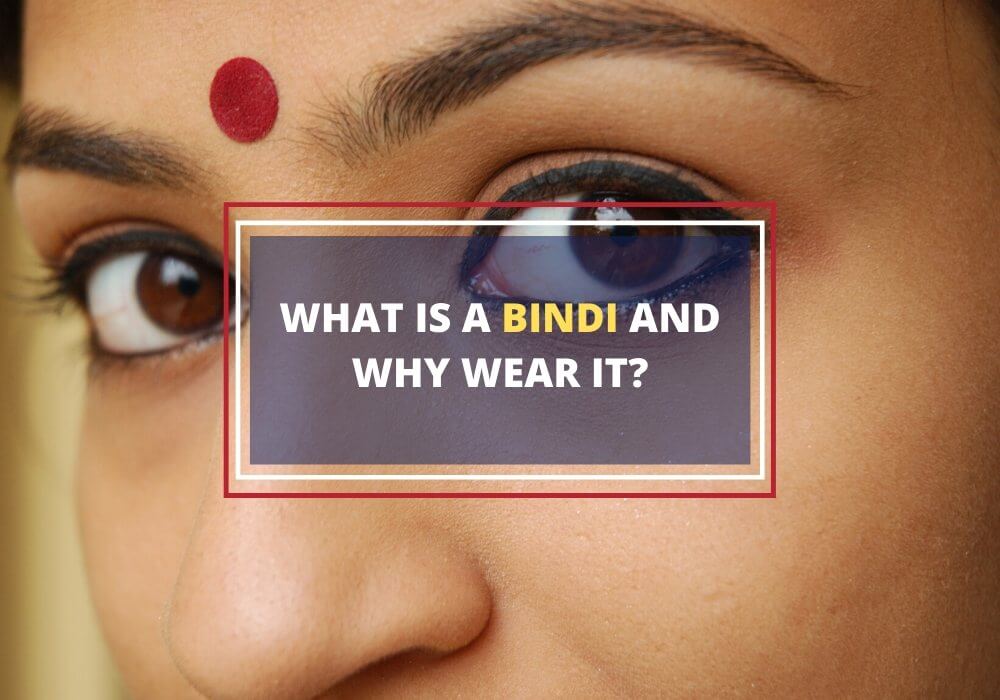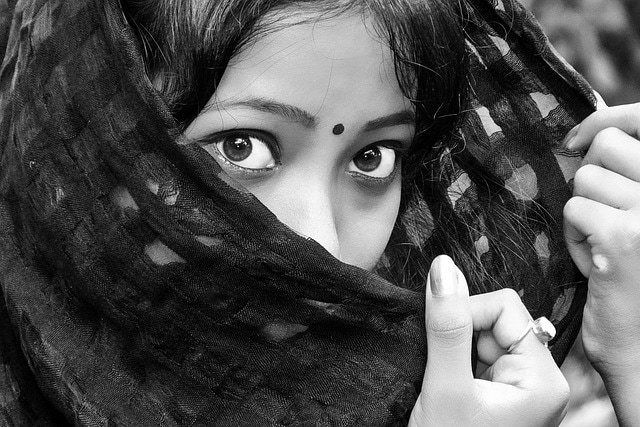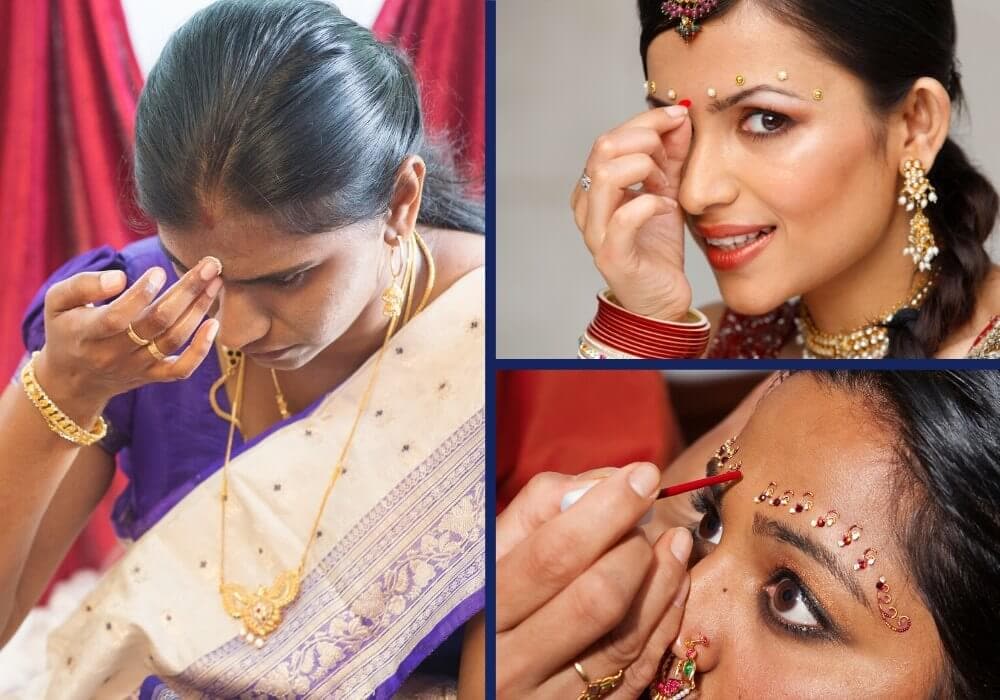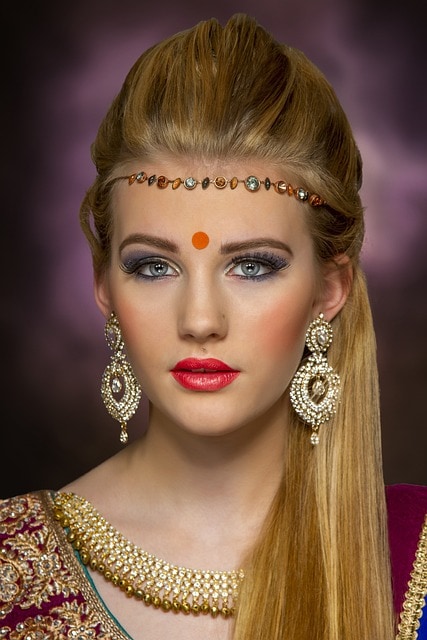
Table of Contents
The bindi is a small but meaningful symbol with deep historical roots. Commonly worn by women in South Asian cultures, the bindi goes beyond just being a decorative item. It symbolizes tradition, spirituality, and identity.
Let’s explore the bindi’s vibrant beginnings, its cultural importance, and how its meanings have changed over time.
What is a Bindi?

A bindi is a small decorative mark that women in South Asian cultures often wear on their foreheads. Usually, it’s a bright red dot, but it can come in other colors and designs too. Women wear it in the middle of their forehead, between the eyebrows, a place that holds spiritual importance in Hinduism.
The meaning of the bindi varies. For some, it’s a cultural or aesthetic item, while for others, it has religious and spiritual significance. Often, it shows if a woman is married.
The bindi has also become a fashion item, changing in style, size, and color to fit modern fashion. It’s not only for traditional clothing but also for modern styles, making it a versatile fashion and beauty accessory.
History of the Bindi
The bindi’s history begins in ancient South Asian traditions, with its first mentions in Hindu scriptures called the Vedas. Originally, it was more than just a beauty mark; it was a powerful symbol. The bindi started as a circular mark of vermilion powder, known as ‘kumkum’, mainly worn by Hindu women to show they were married, symbolizing energy and prosperity.
As time passed, the bindi’s meanings changed in different cultural and religious settings. In Hinduism, it’s often linked to the third eye, or the Ajna chakra, symbolizing wisdom and focus. It’s placed on the forehead, believed to be a point of hidden wisdom and spiritual power.
Beyond its religious meaning, the bindi has become a fashion item, evolving with modern styles. It has crossed religious lines, turning into a popular fashion accessory. Today’s bindis vary in shape, color, and design, appealing to a wide range of tastes.
This shift from a traditional emblem to a modern fashion item shows the bindi’s adaptability and lasting importance in South Asian culture and beyond.
Bindi Symbolism and Meaning

There are several interpretations of the bindi in Hinduism, Jainism and Buddhism. Some are more well-known than others. It’s important to note that there isn’t a general consensus on what the bindi means. Let’s check out some of the most famous interpretations of the ‘red dot’.
- The Ajna Chakra or Third Eye
Thousands of years back, the sages known as rish-muni composed religious texts in Sanskrit called Vedas. In these texts, they’d written about certain focal areas in the body which are said to contain concentrated energy.
These focal points were called the chakras and they run down the center of the body. The sixth chakra (famously called the third eye or ajna chakra) is the exact point where the bindi is applied and this area is said to be where wisdom is concealed.
The purpose of the bindi is to enhance the powers of the third eye, which helps a person to access their inner guru or wisdom .This allows them to view the world and interpret certain things in a manner that’s truth and unbiased.
It also allows a person to rid themselves of their ego and all negative characteristics. As the third eye, the bindi is also worn to ward off the evil eye and bad luck, bringing only good fortune into one’s life.
- A Symbol of Piety
According to the Hindus, everyone has a third eye which can’t be seen. The physical eyes are used to see the external world and the third one inside focuses towards god. Therefore, the red bindi symbolizes piety and also serves as a reminder to give the gods the central place in one’s thoughts.
- The Bindi as a Mark of Marriage
The bindi symbolizes various aspects of Hindu culture, but it’s always been most commonly associated with marriage. Although people apply bindis of all colors and types, the traditional and auspicious bindi is the red one which a woman wears as a sign of marriage. When a Hindu bride enters her husband’s home for the first time as his wife, the red bindi on her forehead is believed to bring prosperity and gives her an important place as the newest guardian in the family.
Hinduism, widowed women aren’t allowed to wear anything that’s associated with married women. A widowed woman would never wear the red dot as it symbolizes a woman’s love and passion for her husband. Instead, a widow would wear a black dot on her forehead in the place where the bindi would be, symbolizing a loss of worldly love.
- The Significance of the Red Bindi
In Hinduism, the color red is extremely significant and symbolizes love, honor and prosperity which is why the bindi is worn in this color. It also represents Shakti (which means strength) and purity and is frequently used for certain auspicious occasions such as the birth of a child, marriages, and festivals.
- The Bindi in Meditation
Deities in religions like Hinduism, Jainism and Buddhism are usually depicted wearing a bindi and meditating. In meditation, their eyes are almost closed and the gaze is focussed right between the eyebrows. This spot is called the Bhrumadhya, which is the spot where one focuses one’s sight so that it would help enhance concentration and is marked using the bindi.
How is the Bindi Applied?

The traditional red bindi is applied by taking a pinch of vermillion powder with the ring-finger and using it to make a dot between the eyebrows. Although it looks easy, it’s quite tricky to apply since it needs to be in the exact location and the edges should be perfectly round.
Beginners usually use a small circular disc to help with the application of the bindi. First, the disc is placed in the right location on the forehead and a sticky waxy paste is applied through the hole in the center. Then, it’s covered with vermillion or kumkum and the disc is removed, leaving a perfectly round bindi.
What Materials are Used for the Bindi?
Originally, bindis were made from a red vermilion powder called ‘kumkum’, a mix of natural turmeric and lime. This traditional material was mainly used for bindis indicating marital status in Hindu culture. Over time, as bindis became fashion items, the materials used to make them expanded.
Now, most modern bindis are self-adhesive stickers made from materials like felt, thin metal, and plastic. Many are decorated with colored glass, glitter, crystals, or rhinestones for extra flair. These sticker bindis vary in shape, size, and color, fitting both traditional and modern styles.
Still, some people prefer the classic look and use kumkum or other powders, applied with a fingertip or stick, allowing for more control over the bindi’s size and shape. This method keeps the traditional feel of the bindi while suiting modern tastes.
The Bindi in Fashion and Jewelry

The bindi has become a popular fashion statement and is worn by women from all corners of the globe regardless of culture and religion. Some wear it as a charm to ward off bad luck whereas others wear it as a forehead decoration, claiming it to be a catchy accessory that draws immediate attention to one’s face and enhances beauty.
There are many types of bindis available on the market in different forms. Some are simply bindi stickers that can be stuck on temporarily. Some women wear jewels in its place. These are intricately designed, made from little beads, gems or other types of jewelry which are far more elaborate. There are all kinds of bindis ranging from plain to fancy bridal bindis.
Nowadays, many Hollywood celebrities like Gwen Stefani, Selena Gomez and Vanessa Hudgens have started wearing bindis as a fashion trend. Those who come from cultures that view the bindi as an auspicious symbol sometimes find it offensive and don’t appreciate important and sacred elements of their culture being used for fashion purposes. Others simply see it as a way of embracing and sharing the Indian culture.
Wrapping Up
The symbolism of the bindi now isn’t adhered to by most people like it was before but it continues to mean a lot more than simply a fashionable red dot on the forehead to South Asian Hindu women. There is a great deal of controversy surrounding the question of who should actually wear the bindi and this continues to be a highly debated topic.








